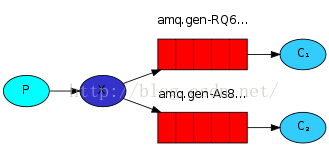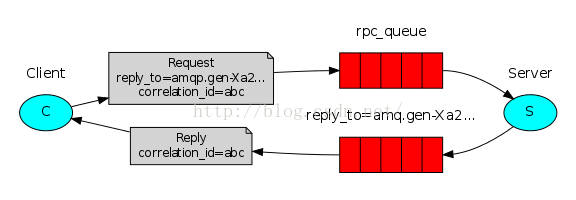1.啟動rabbimq、mysql
在“”執行“”裡輸入services.msc,找到rabbimq、mysql啟動即可
2.啟動redis
管理員進入cmd,進入redis所在目錄,執行redis-server.exe redis.windows.conf --maxmemory 200M 啟動redis server
執行redis-cli.exe啟動客戶端
一、 python系列之 RabbitMQ - hello world
介紹
import pika
import sys
username = 'wt' #rabbitmq使用者名稱
pwd = ' #rabbitmq密碼
user_pwd = pika.PlainCredentials(username, pwd)
s_conn = pika.BlockingConnection(pika.ConnectionParameters('192.168.1.240', credentials=user_pwd))
chan = s_conn.channel()
print('hello')
或者 :
- credentials = pika.PlainCredentials('guest', 'geust')
- #這裡可以連線遠端IP,請記得開啟遠端埠
- parameters = pika.ConnectionParameters('localhost',5672,'/',credentials)
- connection = pika.BlockingConnection(parameters)
- channel = connection.channel()

Queue(佇列):queue就是一個"郵箱"的簡稱,它存在於RabbitMQ內部。雖然訊息在RabbitMQ和你的應用之間傳輸,但他們只能儲存在一 個佇列(queue)裡面。佇列是不受任何限制的約束,你可以想存多少就存多少 - 它本質上是一個無限的緩衝區。

Consumer(消費者):類似一個接收者, 一個 Consumer 是一個等待接收訊息的程式,以下我們簡稱 “C"

Hello World

- 我們這裡講的RabbitMQ採用的是AMQP 0.9.1 ,一個開放的、通用的訊息協議,在不同的語言中有很多的不同的RabbitMQ客戶端,我們下面使用的是pika, 這個是RabbitMQ小組推薦的python客戶端
Sending:

- import pika
- s_connec = pika.BlockingConnection(pika.ConnectionParameters('loaclhost'))
- chan = s_connec.channel()
我們現在就建立了連線了,由於我們中介軟體在本機所以這裡的設定的是“localhost",如果我們想連線到一個不同的伺服器,只 需要簡單的將”localhost" 改為 伺服器的主機名或IP地址.
- chan.queue_declare(queue='hello')
到這點我們就可以傳送一個訊息了,我們的第一個訊息將正式包含一個字串“hello world",將這個訊息傳送到 ”hello“佇列 在RabbitMQ中,一個訊息不能直接傳送到一個佇列中,通常需要通過一個交換(exchange),我們在後面的部分將詳細講解 exchange ,現在所有我們需要知道的是如何利用一個空字串標識預設的exchange。這個一個特殊的exchange -- 它使我們能夠確切地指定訊息應該到哪個佇列去。 這裡需要在 routing_key 引數中指定傳送的佇列名:
- chan.basic_publish(exchange="",
- routing_key='hello',
- body="hello world")
- print(" [x] Sent 'Hello World!'")
在我們退出應用程式之前,我們需要確認網路緩衝區已經flush而且訊息已經確認傳送到了RabbitMQ中,我們可以使用下面的程式碼來關閉連線
- s_connec.close()
Receiving

- connection = pika.BlockingConnection(pika.ConnectionParameters(
- host='localhost'))
- channel = connection.channel()
下一步和之前一樣也需要確認佇列是否存在,使用 queue_declare 建立一個佇列。 你可能會問為什麼還需要在建立一次佇列,我們在上面的程式碼中已經建立了一次了。因為我們不能確認佇列是否已經存在了,如果我們的服務端還未啟動,佇列也就沒有建立,這個時候客戶端啟動了,就找不到佇列。為了避免這個問題就需要在客戶端和服務端均建立一下,這樣就能保證無論是服務端還是客戶端先啟動佇列都存在
- channel.queue_declare(queue='hello')
- 可以在伺服器上通過執行以下命令檢視佇列資訊
- $ sudo rabbitmqctl list_queues
從佇列接收訊息要更復雜一些,它需要為佇列訂閱一個 callback 函式來進行接收。當我們接收一個訊息後,這個 callback 函式將會被 pika函式庫自動呼叫, 在我們的這個例項裡面這個函式將用來列印接收的訊息內容到螢幕
- def callback(ch, method, properties, body):
- print(" [x] Received %r" % body)
下一步我們需要告訴RabbitMQ這個特殊的 callback 函式需要從我們的hello佇列接收訊息
- channel.basic_consume(callback,
- queue='hello',
- no_ack=True)
no_ack 引數將在後面的部分講解
- print(' [*] Waiting for messages. To exit press CTRL+C')
- channel.start_consuming()
完整程式碼:
- import pika
- connection = pika.BlockingConnection(pika.ConnectionParameters(host='localhost'))
- channel = connection.channel()
- channel.queue_declare(queue='hello')
- channel.basic_publish(exchange='',
- routing_key='hello',
- body='Hello World!')
- print(" [x] Sent 'Hello World!'")
- connection.close()

Consumer:receive.py
- import pika
- def callback(ch, method, properties, body):
- print(" [x] Received %r" % body)
- connection = pika.BlockingConnection(pika.ConnectionParameters(host='localhost'))
- channel = connection.channel()
- channel.queue_declare(queue='hello')
- channel.basic_consume(callback,
- queue='hello',
- no_ack=True)
- print(' [*] Waiting for messages. To exit press CTRL+C')
- channel.start_consuming()
二、python系列之 RabbitMQ - work queues

預備
- import pika
- import sys
- message = ' '.join(sys.argv[1:]) or "Hello World"
- channel.basic_publish(exchange='',
- routing_key='worker',
- body=message,
- properties=pika.BasicProperties(delivery_mode = 2,)
- )
- print(" [x] Send %r " % message)
之前老的 receive.py 指令碼也需要一些改變,我們對處理模組 callback 函式進行一些修改:它假裝對訊息中的每個小數點需要1秒時間進行處理,它將會從訊息佇列中pop一個訊息然後執行任務,我們用 worker.py 來命名這個檔案
- import time
- def callback(ch, method, properties, body):
- print(" [x] Received %r" % body)
- time.sleep(body.count(b'.'))
- print(" [x] Done")
- ch.basic_ack(delivery_tag = method.delivery_tag)
迴圈排程(Round-robin dispatching)
- shell1$ python worker.py
- [*] Waiting for messages. To exit press CTRL+C
- shell2$ python worker.py
- [*] Waiting for messages. To exit press CTRL+C
再開啟一個終端,執行 new_task.py ,執行多個任務
- shell3$ python new_task.py First message.
- shell3$ python new_task.py Second message..
- shell3$ python new_task.py Third message...
- shell3$ python new_task.py Fourth message....
- shell3$ python new_task.py Fifth message.....
讓我們看看兩個worker端接收的訊息:
- shell1$ python worker.py
- [*] Waiting for messages. To exit press CTRL+C
- [x] Received 'First message.'
- [x] Received 'Third message...'
- [x] Received 'Fifth message.....'
- shell2$ python worker.py
- [*] Waiting for messages. To exit press CTRL+C
- [x] Received 'Second message..'
- [x] Received 'Fourth message....'
預設,RabbitMQ將迴圈的傳送每個訊息到下一個Consumer , 平均每個Consumer都會收到同樣數量的訊息。 這種分發訊息的方式成為 迴圈排程(round-robin)
- import pika
- import sys
- connec = pika.BlockingConnection(pika.ConnectionParameters(host='localhost'))
- channel = connec.channel()
- channel.queue_declare(queue='worker')
- message = ' '.join(sys.argv[1:]) or "Hello World"
- channel.basic_publish(exchange='',
- routing_key='worker',
- body=message,
- properties=pika.BasicProperties(delivery_mode = 2,)
- )
- print(" [x] Send %r " % message)
worker.py
- import time
- import pika
- connect = pika.BlockingConnection(pika.ConnectionParameters(host='localhost'))
- channel = connect.channel()
- channel.queue_declare('worker')
- def callback(ch, method, properties,body):
- print(" [x] Received %r" % body)
- time.sleep(body.count(b'.'))
- print(" [x] Done")
- ch.basic_ack(delivery_tag = method.delivery_tag)
- channel.basic_consume(callback,
- queue='worker',
- )
- channel.start_consuming()
訊息確認(Message acknowledgment)
執行一個任務能消耗幾秒. 你可能想知道當一個consumer在執行一個艱鉅任務或執行到一半是死掉了會發生什麼。就我們當前的程式碼而言,一旦RabbitMQ 的分發完訊息給 consumer後 就立即從記憶體中移除該訊息。這樣的話,如果一個worker剛啟動你就結束掉,那麼訊息就丟失了。那麼所有傳送給這個 worker 的還沒有處理完成的訊息也將丟失。
- def callback(ch, method, properties, body):
- print " [x] Received %r" % (body,)
- time.sleep( body.count('.') )
- print " [x] Done"
- ch.basic_ack(delivery_tag = method.delivery_tag)
- channel.basic_consume(callback,
- queue='hello')
使用這個程式碼我們能確保即使在程式執行中使用CTRL+C結束worker程序也不會有訊息丟失。之後當worker死掉之後所有未確認的訊息將會重新進行轉發。
- 忘了 acknowlegement
- 忘記設定basic_ack是一個經常犯也很容易犯的錯誤,但後果是很嚴重的。當客戶端退出後訊息將會重新轉發,但RabbitMQ會因為不能釋放那些沒有回覆的訊息而消耗越來越多的記憶體
- 為了除錯(debug)這種型別的錯誤,你可以使用 rabbitmqctl 列印 message_unacknowledged 欄位:
- $ sudo rabbitmqctl list_queues name messages_ready messages_unacknowledged
- Listing queues ...
- hello 0 0
- ...done
訊息持久化(Message durability)
我們已經學習了即使客戶端死掉了任務也不會丟失。但是如果RabbitMQ服務停止了的話,我們的任務還是會丟失。
- channel.queue_declare(queue='hello', durable=True
儘管此命令本身定義是正確的,但我們設定後還是不會工作。因為我們已經定義了個名為 hello ,但不是durable屬性的佇列。RabbitMQ不允許你重新定義一個已經存在、但屬性不同的queue。RabbitMQ 將會給定義這個屬性的程式返回一個錯誤。但這裡有一個快速的解決方法:讓我們定義個不同名稱的佇列,比如 task_queue:
- channel.queue_declare(queue='task_queue', durable=True)
這個 queue_declare 需要在 生產者(producer) 和消費方(consumer) 程式碼中都進行設定。
- channel.basic_publish(exchange='',
- routing_key="task_queue",
- body=message,
- properties=pika.BasicProperties(
- delivery_mode = 2, # make message persistent
- ))
訊息持久化的注意點
公平排程(Fair dispatch)

- channel.basic_qos(prefetch_count=1)
程式碼彙總
- import pika
- import sys
- connection = pika.BlockingConnection(pika.ConnectionParameters(
- host='localhost'))
- channel = connection.channel()
- channel.queue_declare(queue='task_queue', durable=True) # 設定佇列為持久化的佇列
- message = ' '.join(sys.argv[1:]) or "Hello World!"
- channel.basic_publish(exchange='',
- routing_key='task_queue',
- body=message,
- properties=pika.BasicProperties(
- delivery_mode = 2, # 設定訊息為持久化的
- ))
- print(" [x] Sent %r" % message)
- connection.close()
new_task.py 指令碼
- #!/usr/bin/env python
- import pika
- import time
- connection = pika.BlockingConnection(pika.ConnectionParameters(
- host='localhost'))
- channel = connection.channel()
- channel.queue_declare(queue='task_queue', durable=True) # 設定佇列持久化
- print(' [*] Waiting for messages. To exit press CTRL+C')
- def callback(ch, method, properties, body):
- print(" [x] Received %r" % body)
- time.sleep(body.count(b'.'))
- print(" [x] Done")
- ch.basic_ack(delivery_tag = method.delivery_tag)
- channel.basic_qos(prefetch_count=1) # 訊息未處理完前不要傳送資訊的訊息
- channel.basic_consume(callback,
- queue='task_queue')
- channel.start_consuming()
二、 python系列之 RabbitMQ -- Publish/Subscribe
前面的部分我們建立了一個工作佇列(work queue). 設想是每個任務都能分發到一個worker,這一部分我們將會做一些完全不同的事情 -- 我們將會分發一個訊息到多個消費方(consumer),這種模式被譽為釋出/訂閱(publish/subscribe)模式
為了闡明這種模式,我們將要建立一個簡單的日誌系統,由兩部分程式組成 -- 第一部分將要釋出日誌訊息,第二部分接收並列印
在我們的日誌系統中每個接收程式(receiver)將接收訊息並複製訊息內容,這樣我們將會執行一個receiver 記錄日誌到磁碟;與此同時我們執行另一個receiver輸入日誌到螢幕檢視。
本質上,釋出日誌訊息將會廣播到所有的receivers
交換 (Exchanges)

- channel.exchange_declare(exchange='logs',
- type='fanout')
fanout exchange非常簡單,你從這個名字中就能猜出來,它將從Producer方收到的訊息廣播給所有他知道的receiver方。而這正是我們的logger記錄所需要的訊息。
- $ sudo rabbitmqctl list_exchanges
- Listing exchanges ...
- logs fanout
- amq.direct direct
- amq.topic topic
- amq.fanout fanout
- amq.headers headers
- ...done.
在這個列表中有一些amq.* exchange和預設的exchange,這些都是預設建立的,但是這些未必是你所需要的。
- channel.basic_publish(exchange='',
- routing_key='hello',
- body=message)
這個exchange引數就是這個exchange的名字. 空字串標識預設的或者匿名的exchange:如果存在routing_key, 訊息路由到routing_key指定的佇列中。
- channel.basic_publish(exchange='logs',
- routing_key='',
- body=message)
臨時佇列( Temporary queues )
你應該記得我們之前使用有一個特定名字的佇列( hello、task_queue). 設定佇列名對我們來說是至關重要的 --- 我們需要給消費方指定同樣的佇列名字。 要在生產者和消費者之間共享佇列,給佇列設定一個名字是非常重要的。
- result = channel.queue_declare()
這樣, result.method.queue 包含一個隨機的佇列名, 比如:看起來像 amq.gen-JzTY20BRgKO-HjmUJj0wLg.
- result = channel.queue_declare(exclusive=True)
繫結(Bindings)

- channel.queue_bind(exchange='logs',
- queue=result.method.queue)
現在logs exchange 將要傳送訊息到我們的佇列
- 你可以在Server端通過rabbitmqctl list_bindings命令檢視繫結資訊
彙總(Putting it all together)

- import pika
- import sys
- connection = pika.BlockingConnection(pika.ConnectionParameters(
- host='localhost'))
- channel = connection.channel()
- channel.exchange_declare(exchange='logs',
- type='fanout')
- message = ' '.join(sys.argv[1:]) or "info: Hello World!"
- channel.basic_publish(exchange='logs',
- routing_key='',
- body=message)
- print(" [x] Sent %r" % message)
- connection.close()
如你所見, 當建立連線之後我們定義了一個exchange名logs, 由於釋出一個訊息到一個不存在的exchange是禁止的,所以這一步是必須有的。
- import pika
- connection = pika.BlockingConnection(pika.ConnectionParameters(
- host='localhost'))
- channel = connection.channel()
- channel.exchange_declare(exchange='logs',
- type='fanout')
- result = channel.queue_declare(exclusive=True) # 佇列斷開後自動刪除臨時佇列
- queue_name = result.method.queue # 佇列名採用服務端分配的臨時佇列
- channel.queue_bind(exchange='logs',
- queue=queue_name)
- print(' [*] Waiting for logs. To exit press CTRL+C')
- def callback(ch, method, properties, body):
- print(" [x] %r" % body)
- channel.basic_consume(callback,
- queue=queue_name,
- no_ack=True)
- channel.start_consuming()
- $ python receive_logs.py > logs_from_rabbit.log
如果你想在螢幕上檢視輸出的日誌,新開一個終端並執行:
- $ python receive_logs.py
當然,發出日誌資訊:
- $ python emit_log.py
使用 rabbitmqlctl list_bindings 你能驗證程式碼確實建立了你想要的binding和佇列。執行兩個 receive_logs.py 程式你可以看到:
- $ sudo rabbitmqctl list_bindings
- Listing bindings ...
- logs exchange amq.gen-JzTY20BRgKO-HjmUJj0wLg queue []
- logs exchange amq.gen-vso0PVvyiRIL2WoV3i48Yg queue []
- ...done.
這個結果的解釋非常直白: 從 logs exchange 出來的資料傳送服務端自動分配的到兩個佇列名中,這也是我們預期的。
遠端過程呼叫(Remote procedure call (RPC))
在第二課我們學習了怎樣使用 工作佇列(work queues) 來在多個workers之間分發需要消時的 任務
但是如果我們需要在遠端的伺服器上呼叫一個函式並獲取返回結果 我們需要怎麼做呢?well這是一個不一樣的故事。 這中模式通常被稱為遠端過程呼叫或RPC
在這一刻我們將要使用RabbitMQ來建立一個RPC系統:一個客戶端和一個可擴充套件的RPC服務。由於我們沒有任何耗時的任務值得分配,我們將要建立一個仿RPC服務並返回斐波納契數值
客戶端介面(Client interface)
- fibonacci_rpc = FibonacciRpcClient()
- result = fibonacci_rpc.call(4)
- print("fib(4) is %r" % result)
回撥佇列(callback queue)
- result = channel.queue_declare(exclusive=True)
- callback_queue = result.method.queue
- channel.basic_publish(exchange='',
- routing_key='rpc_queue',
- properties=pika.BasicProperties(
- reply_to = callback_queue,
- ),
- body=request)
關聯ID (Correlation ID)
概要(Summary)

整合
- #!/usr/bin/env python
- import pika
- connection = pika.BlockingConnection(pika.ConnectionParameters(
- host='localhost'))
- channel = connection.channel()
- channel.queue_declare(queue='rpc_queue')
- def fib(n):
- if n == 0:
- return 0
- elif n == 1:
- return 1
- else:
- return fib(n-1) + fib(n-2)
- def on_request(ch, method, props, body):
- n = int(body)
- print(" [.] fib(%s)" % n)
- response = fib(n)
- ch.basic_publish(exchange='',
- routing_key=props.reply_to,
- properties=pika.BasicProperties(correlation_id = \
- props.correlation_id),
- body=str(response))
- ch.basic_ack(delivery_tag = method.delivery_tag)
- channel.basic_qos(prefetch_count=1)
- channel.basic_consume(on_request, queue='rpc_queue')
- print(" [x] Awaiting RPC requests")
- channel.start_consuming()
- #!/usr/bin/env python
- import pika
- import uuid
- class FibonacciRpcClient(object):
- def __init__(self):
- self.connection = pika.BlockingConnection(pika.ConnectionParameters(
- host='localhost'))
- self.channel = self.connection.channel()
- result = self.channel.queue_declare(exclusive=True)
- self.callback_queue = result.method.queue
- self.channel.basic_consume(self.on_response, no_ack=True,
- queue=self.callback_queue)
- def on_response(self, ch, method, props, body):
- if self.corr_id == props.correlation_id:
- self.response = body
- def call(self, n):
- self.response = None
- self.corr_id = str(uuid.uuid4())
- self.channel.basic_publish(exchange='',
- routing_key='rpc_queue',
- properties=pika.BasicProperties(
- reply_to = self.callback_queue,
- correlation_id = self.corr_id,
- ),
- body=str(n))
- while self.response is None:
- self.connection.process_data_events()
- return int(self.response)
- fibonacci_rpc = FibonacciRpcClient()
- print(" [x] Requesting fib(30)")
- response = fibonacci_rpc.call(30)
- print(" [.] Got %r" % response)
- $ python rpc_server.py
- [x] Awaiting RPC requests
請求一個斐波那契數,執行客戶端
- $ python rpc_client.py
- [x] Requesting fib(30)
四、redis
2.在python中操作如下:
set(name, value, ex=None, px=None, nx=False, xx=False)
在Redis中設定值,預設,不存在則建立,存在則修改引數:ex,過期時間(秒)px,過期時間(毫秒)nx,如果設定為True,則只有name不存在時,當前set操作才執行xx,如果設定為True,則只有name存在時,崗前set操作才執行setnx(name, value)
設定值,只有name不存在時,執行設定操作(新增)setex(name, value, time)
# 設定值# 引數:# time,過期時間(數字秒 或 timedelta物件)psetex(name, time_ms, value)
# 設定值# 引數:# time_ms,過期時間(數字毫秒 或 timedelta物件)mset(*args, **kwargs)
批量設定值如:mset(k1='v1', k2='v2')或mget({'k1':'v1','k2':'v2'})get(name)
獲取值mget(keys, *args)
批量獲取如:mget('ylr','wupeiqi')或r.mget(['ylr','wupeiqi'])getset(name, value)
設定新值並獲取原來的值getrange(key, start, end)
# 獲取子序列(根據位元組獲取,非字元)# 引數:# name,Redis 的 name# start,起始位置(位元組)# end,結束位置(位元組)# 如: "武沛齊" ,0-3表示 "武"setrange(name, offset, value)
# 修改字串內容,從指定字串索引開始向後替換(新值太長時,則向後新增)# 引數:# offset,字串的索引,位元組(一個漢字三個位元組)# value,要設定的值setbit(name, offset, value)
# 對name對應值的二進位制表示的位進行操作# 引數:# name,redis的name# offset,位的索引(將值變換成二進位制後再進行索引)# value,值只能是 1 或 0# 注:如果在Redis中有一個對應: n1 = "foo",那麼字串foo的二進位制表示為:011001100110111101101111所以,如果執行 setbit('n1',7,1),則就會將第7位設定為1,那麼最終二進位制則變成011001110110111101101111,即:"goo"# 擴充套件,轉換二進位制表示:# source = "武沛齊"source="foo"foriinsource:num=ord(i)bin(num).replace('b','')特別的,如果source是漢字"武沛齊"怎麼辦?答:對於utf-8,每一個漢字佔3個位元組,那麼"武沛齊"則有9個位元組對於漢字,for迴圈時候會按照 位元組 迭代,那麼在迭代時,將每一個位元組轉換 十進位制數,然後再將十進位制數轉換成二進位制111001101010110110100110111001101011001010011011111010011011110110010000------------------------------------------------------------------------------------武 沛 齊getbit(name, offset)
# 獲取name對應的值的二進位制表示中的某位的值 (0或1)bitcount(key, start=None, end=None)
# 獲取name對應的值的二進位制表示中 1 的個數# 引數:# key,Redis的name# start,位起始位置# end,位結束位置bitop(operation, dest, *keys)
# 獲取多個值,並將值做位運算,將最後的結果儲存至新的name對應的值# 引數:# operation,AND(並) 、 OR(或) 、 NOT(非) 、 XOR(異或)# dest, 新的Redis的name# *keys,要查詢的Redis的name# 如:bitop("AND",'new_name','n1','n2','n3')# 獲取Redis中n1,n2,n3對應的值,然後講所有的值做位運算(求並集),然後將結果儲存 new_name 對應的值中strlen(name)
# 返回name對應值的位元組長度(一個漢字3個位元組)incr(self, name, amount=1)
# 自增 name對應的值,當name不存在時,則建立name=amount,否則,則自增。# 引數:# name,Redis的name# amount,自增數(必須是整數)# 注:同incrbyincrbyfloat(self, name, amount=1.0)
# 自增 name對應的值,當name不存在時,則建立name=amount,否則,則自增。# 引數:# name,Redis的name# amount,自增數(浮點型)decr(self, name, amount=1)
# 自減 name對應的值,當name不存在時,則建立name=amount,否則,則自減。# 引數:# name,Redis的name# amount,自減數(整數)append(key, value)
# 在redis name對應的值後面追加內容# 引數:key, redis的namevalue, 要追加的字串
Hash操作,redis中Hash在記憶體中的儲存格式如下圖:

hset(name, key, value)
# name對應的hash中設定一個鍵值對(不存在,則建立;否則,修改)# 引數:# name,redis的name# key,name對應的hash中的key# value,name對應的hash中的value# 注:# hsetnx(name, key, value),當name對應的hash中不存在當前key時則建立(相當於新增)hmset(name, mapping)
# 在name對應的hash中批量設定鍵值對# 引數:# name,redis的name# mapping,字典,如:{'k1':'v1', 'k2': 'v2'}# 如:# r.hmset('xx', {'k1':'v1', 'k2': 'v2'})hget(name,key)
# 在name對應的hash中獲取根據key獲取valuehmget(name, keys, *args)
# 在name對應的hash中獲取多個key的值# 引數:# name,reids對應的name# keys,要獲取key集合,如:['k1', 'k2', 'k3']# *args,要獲取的key,如:k1,k2,k3# 如:# r.mget('xx', ['k1', 'k2'])# 或# print r.hmget('xx', 'k1', 'k2')hgetall(name)
獲取name對應hash的所有鍵值hlen(name)
# 獲取name對應的hash中鍵值對的個數hkeys(name)
# 獲取name對應的hash中所有的key的值hvals(name)
# 獲取name對應的hash中所有的value的值hexists(name, key)
# 檢查name對應的hash是否存在當前傳入的keyhdel(name,*keys)
# 將name對應的hash中指定key的鍵值對刪除hincrby(name, key, amount=1)
# 自增name對應的hash中的指定key的值,不存在則建立key=amount# 引數:# name,redis中的name# key, hash對應的key# amount,自增數(整數)hincrbyfloat(name, key, amount=1.0)
# 自增name對應的hash中的指定key的值,不存在則建立key=amount# 引數:# name,redis中的name# key, hash對應的key# amount,自增數(浮點數)# 自增name對應的hash中的指定key的值,不存在則建立key=amounthscan(name, cursor=0, match=None, count=None)
# 增量式迭代獲取,對於資料大的資料非常有用,hscan可以實現分片的獲取資料,並非一次性將資料全部獲取完,從而放置記憶體被撐爆# 引數:# name,redis的name# cursor,遊標(基於遊標分批取獲取資料)# match,匹配指定key,預設None 表示所有的key# count,每次分片最少獲取個數,預設None表示採用Redis的預設分片個數# 如:# 第一次:cursor1, data1 = r.hscan('xx', cursor=0, match=None, count=None)# 第二次:cursor2, data1 = r.hscan('xx', cursor=cursor1, match=None, count=None)# ...# 直到返回值cursor的值為0時,表示資料已經通過分片獲取完畢hscan_iter(name, match=None, count=None)
# 利用yield封裝hscan建立生成器,實現分批去redis中獲取資料# 引數:# match,匹配指定key,預設None 表示所有的key# count,每次分片最少獲取個數,預設None表示採用Redis的預設分片個數# 如:# for item in r.hscan_iter('xx'):# print item
List操作,redis中的List在在記憶體中按照一個name對應一個List來儲存。如圖:

lpush(name,values)
# 在name對應的list中新增元素,每個新的元素都新增到列表的最左邊# 如:# r.lpush('oo', 11,22,33)# 儲存順序為: 33,22,11# 擴充套件:# rpush(name, values) 表示從右向左操作lpushx(name,value)
# 在name對應的list中新增元素,只有name已經存在時,值新增到列表的最左邊# 更多:# rpushx(name, value) 表示從右向左操作llen(name)
# name對應的list元素的個數linsert(name, where, refvalue, value))
# 在name對應的列表的某一個值前或後插入一個新值# 引數:# name,redis的name# where,BEFORE或AFTER# refvalue,標杆值,即:在它前後插入資料# value,要插入的資料r.lset(name, index, value)
# 對name對應的list中的某一個索引位置重新賦值# 引數:# name,redis的name# index,list的索引位置# value,要設定的值r.lrem(name, value, num)
# 在name對應的list中刪除指定的值# 引數:# name,redis的name# value,要刪除的值# num, num=0,刪除列表中所有的指定值;# num=2,從前到後,刪除2個;# num=-2,從後向前,刪除2個lpop(name)
# 在name對應的列表的左側獲取第一個元素並在列表中移除,返回值則是第一個元素# 更多:# rpop(name) 表示從右向左操作lindex(name, index)
在name對應的列表中根據索引獲取列表元素lrange(name, start, end)
# 在name對應的列表分片獲取資料# 引數:# name,redis的name# start,索引的起始位置# end,索引結束位置ltrim(name, start, end)
# 在name對應的列表中移除沒有在start-end索引之間的值# 引數:# name,redis的name# start,索引的起始位置# end,索引結束位置rpoplpush(src, dst)
# 從一個列表取出最右邊的元素,同時將其新增至另一個列表的最左邊# 引數:# src,要取資料的列表的name# dst,要新增資料的列表的nameblpop(keys, timeout)
# 將多個列表排列,按照從左到右去pop對應列表的元素# 引數:# keys,redis的name的集合# timeout,超時時間,當元素所有列表的元素獲取完之後,阻塞等待列表內有資料的時間(秒), 0 表示永遠阻塞# 更多:# r.brpop(keys, timeout),從右向左獲取資料brpoplpush(src, dst, timeout=0)
# 從一個列表的右側移除一個元素並將其新增到另一個列表的左側# 引數:# src,取出並要移除元素的列表對應的name# dst,要插入元素的列表對應的name# timeout,當src對應的列表中沒有資料時,阻塞等待其有資料的超時時間(秒),0 表示永遠阻塞自定義增量迭代
# 由於redis類庫中沒有提供對列表元素的增量迭代,如果想要迴圈name對應的列表的所有元素,那麼就需要:# 1、獲取name對應的所有列表# 2、迴圈列表# 但是,如果列表非常大,那麼就有可能在第一步時就將程式的內容撐爆,所有有必要自定義一個增量迭代的功能:deflist_iter(name):"""自定義redis列表增量迭代:param name: redis中的name,即:迭代name對應的列表:return: yield 返回 列表元素"""list_count=r.llen(name)forindexinxrange(list_count):yieldr.lindex(name, index)# 使用foriteminlist_iter('pp'):itemSet操作,Set集合就是不允許重複的列表
sadd(name,values)
# name對應的集合中新增元素scard(name)
獲取name對應的集合中元素個數sdiff(keys, *args)
在第一個name對應的集合中且不在其他name對應的集合的元素集合sdiffstore(dest, keys, *args)
# 獲取第一個name對應的集合中且不在其他name對應的集合,再將其新加入到dest對應的集合中sinter(keys, *args)
# 獲取多一個name對應集合的並集sinterstore(dest, keys, *args)
# 獲取多一個name對應集合的並集,再講其加入到dest對應的集合中sismember(name, value)
# 檢查value是否是name對應的集合的成員smembers(name)
# 獲取name對應的集合的所有成員smove(src, dst, value)
# 將某個成員從一個集合中移動到另外一個集合spop(name)
# 從集合的右側(尾部)移除一個成員,並將其返回srandmember(name, numbers)
# 從name對應的集合中隨機獲取 numbers 個元素srem(name, values)
# 在name對應的集合中刪除某些值sunion(keys, *args)
# 獲取多一個name對應的集合的並集sunionstore(dest,keys, *args)
# 獲取多一個name對應的集合的並集,並將結果儲存到dest對應的集合中sscan(name, cursor=0, match=None, count=None)
sscan_iter(name, match=None, count=None)
# 同字串的操作,用於增量迭代分批獲取元素,避免記憶體消耗太大
有序集合,在集合的基礎上,為每元素排序;元素的排序需要根據另外一個值來進行比較,所以,對於有序集合,每一個元素有兩個值,即:值和分數,分數專門用來做排序。
zadd(name, *args, **kwargs)
# 在name對應的有序集合中新增元素# 如:# zadd('zz', 'n1', 1, 'n2', 2)# 或# zadd('zz', n1=11, n2=22)zcard(name)
# 獲取name對應的有序集合元素的數量zcount(name, min, max)
# 獲取name對應的有序集合中分數 在 [min,max] 之間的個數zincrby(name, value, amount)
# 自增name對應的有序集合的 name 對應的分數r.zrange( name, start, end, desc=False, withscores=False, score_cast_func=float)
# 按照索引範圍獲取name對應的有序集合的元素# 引數:# name,redis的name# start,有序集合索引起始位置(非分數)# end,有序集合索引結束位置(非分數)# desc,排序規則,預設按照分數從小到大排序# withscores,是否獲取元素的分數,預設只獲取元素的值# score_cast_func,對分數進行資料轉換的函式# 更多:# 從大到小排序# zrevrange(name, start, end, withscores=False, score_cast_func=float)# 按照分數範圍獲取name對應的有序集合的元素# zrangebyscore(name, min, max, start=None, num=None, withscores=False, score_cast_func=float)# 從大到小排序# zrevrangebyscore(name, max, min, start=None, num=None, withscores=False, score_cast_func=float)zrank(name, value)
# 獲取某個值在 name對應的有序集合中的排行(從 0 開始)# 更多:# zrevrank(name, value),從大到小排序zrangebylex(name, min, max, start=None, num=None)
# 當有序集合的所有成員都具有相同的分值時,有序集合的元素會根據成員的 值 (lexicographical ordering)來進行排序,而這個命令則可以返回給定的有序集合鍵 key 中, 元素的值介於 min 和 max 之間的成員# 對集合中的每個成員進行逐個位元組的對比(byte-by-byte compare), 並按照從低到高的順序, 返回排序後的集合成員。 如果兩個字串有一部分內容是相同的話, 那麼命令會認為較長的字串比較短的字串要大# 引數:# name,redis的name# min,左區間(值)。 + 表示正無限; - 表示負無限; ( 表示開區間; [ 則表示閉區間# min,右區間(值)# start,對結果進行分片處理,索引位置# num,對結果進行分片處理,索引後面的num個元素# 如:# ZADD myzset 0 aa 0 ba 0 ca 0 da 0 ea 0 fa 0 ga# r.zrangebylex('myzset', "-", "[ca") 結果為:['aa', 'ba', 'ca']# 更多:# 從大到小排序# zrevrangebylex(name, max, min, start=None, num=None)zrem(name, values)
# 刪除name對應的有序集合中值是values的成員# 如:zrem('zz', ['s1', 's2'])zremrangebyrank(name, min, max)
# 根據排行範圍刪除zremrangebyscore(name, min, max)
# 根據分數範圍刪除zremrangebylex(name, min, max)
# 根據值返回刪除zscore(name, value)
# 獲取name對應有序集合中 value 對應的分數zinterstore(dest, keys, aggregate=None)
# 獲取兩個有序集合的交集,如果遇到相同值不同分數,則按照aggregate進行操作# aggregate的值為: SUM MIN MAXzunionstore(dest, keys, aggregate=None)
# 獲取兩個有序集合的並集,如果遇到相同值不同分數,則按照aggregate進行操作# aggregate的值為: SUM MIN MAXzscan(name, cursor=0, match=None, count=None, score_cast_func=float)
zscan_iter(name, match=None, count=None,score_cast_func=float)
# 同字串相似,相較於字串新增score_cast_func,用來對分數進行操作
其他常用操作
delete(*names)
# 根據刪除redis中的任意資料型別exists(name)
# 檢測redis的name是否存在keys(pattern='*')
# 根據模型獲取redis的name# 更多:# KEYS * 匹配資料庫中所有 key 。# KEYS h?llo 匹配 hello , hallo 和 hxllo 等。# KEYS h*llo 匹配 hllo 和 heeeeello 等。# KEYS h[ae]llo 匹配 hello 和 hallo ,但不匹配 hilloexpire(name ,time)
# 為某個redis的某個name設定超時時間rename(src, dst)
# 對redis的name重新命名為move(name, db))
# 將redis的某個值移動到指定的db下randomkey()
# 隨機獲取一個redis的name(不刪除)type(name)
# 獲取name對應值的型別scan(cursor=0, match=None, count=None)
scan_iter(match=None, count=None)
# 同字串操作,用於增量迭代獲取key
4、管道
redis-py預設在執行每次請求都會建立(連線池申請連線)和斷開(歸還連線池)一次連線操作,如果想要在一次請求中指定多個命令,則可以使用pipline實現一次請求指定多個命令,並且預設情況下一次pipline 是原子性操作。
|
2
3
4
5
6
7
8
9
10
11
12
13
14
15
16
|
#!/usr/bin/env python# -*- coding:utf-8 -*-import redispool = redis.ConnectionPool(host='10.211.55.4', port=6379)r = redis.Redis(connection_pool=pool)# pipe = r.pipeline(transaction=False)pipe = r.pipeline(transaction=True)#True為開啟同時請求多個指令的功能pipe.set('name', 'alex')pipe.set('role', 'sb')pipe.execute() |